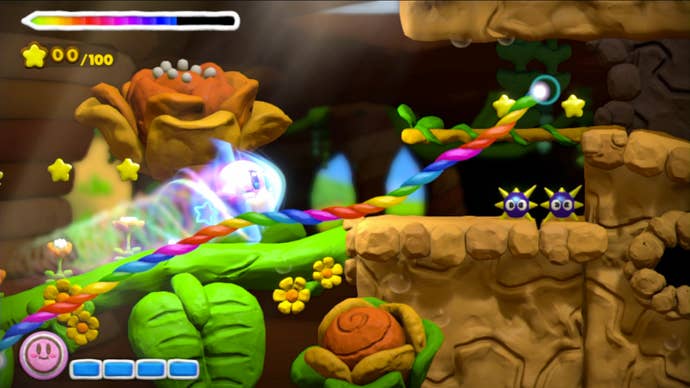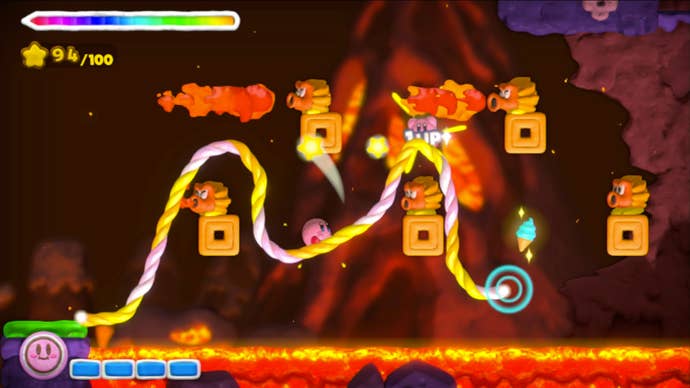Kirby and the Rainbow Curse Wii U Review: Roller Games
Succinct, beautiful, and relentlessly inventive, this stylus-driven gem proves no one knows pure fun better than Nintendo.
This article first appeared on USgamer, a partner publication of VG247. Some content, such as this article, has been migrated to VG247 for posterity after USgamer's closure - but it has not been edited or further vetted by the VG247 team.
While Kirby is typically tasked with starring in cutesy, kid-friendly platformers, the adventures that pull him out of this comfort zone often prove the most interesting. Kirby's Pinball Land, Kirby's Dream Course, Kirby Mass Attack: All of these games take the basic premise of a ball-shaped character and go in a completely unexpected direction, resulting in something far more inspired than the typical Kirby experience. (We'll just forget about Kirby Tilt 'n' Tumble for now.)
One of Kirby's greatest aberrations came in the form of Kirby Canvas Curse, a 2005 DS release that did much to prove the viability of touch-based gaming years before so many of us would occupy our lives with the Crushing of Candy. This latest release, Kirby and the Rainbow Curse, borrows the main conceit of Canvas, but so thoroughly explores the idea that its predecessor looks like an incomplete prototype in comparison. And while it's somewhat strange to play a console game that actively discourages players from looking at their televisions, with Rainbow Curse, we finally have a fully-realized experience that relies entirely on the Wii U's GamePad—and doesn't feel like an undercooked tech demo for something we might see years down the line. (Sorry, NintendoLand.)
Even if you've never played Canvas Curse, the essential mechanics of Rainbow Curse don't require much explanation. Instead of falling under direct control of the player, Kirby sticks to lines drawn onto the screen with the stylus, and can be given a short boost with a quick tap. It's remarkably simple, even more so than Canvas Curse—Kirby's lost his copy ability this time around—but the real fun comes in seeing how many different ways developer Hal Laboratory can get you to carry Kirby from point A to point B using nothing but a rainbow rope.

Rest assured, there's no shortage of ideas in Kirby and the Rainbow Curse. While the game starts off with an extremely straightforward level, from there, Hal puts their genius to work. One of the biggest improvements from Canvas comes in the way you use the stylus to shape the world itself, rather than just for the sake of giving Kirby protection from bottomless pits. From level to level, you'll be digging tunnels for Kirby's use, blocking the flow of water and lava, building reliable tracks for gondola travel, and using the stylus in several other ways to transform the environment. Playing Rainbow Curse effectively means keeping note of Kirby's current trajectory with an eye on upcoming dangers that'll stop him dead in his tracks.
In keeping with the game's sense of inventiveness, some levels diverge a bit from the central premise, and trap Kirby in the form of a vehicle that changes the rainbow rope's essential function. In submarine form, for instance, the rope isn't used to guide Kirby; rather, it's employed to steer the torpedos perpetually firing out of his... tubes. While these new forms help keep the action diverse, thankfully, Rainbow Curse rarely drags out the same idea for a second go. In true Nintendo tradition, once the developers stumble onto a winning concept, they recognize the value in leaving players wanting more. Even fighting bosses a second time doesn't feel disappointing, as these rematches add a meaningful twist that changes the way you approach them entirely. Frankly, HAL might be a little too stubborn with their philosophy, as plenty of novel concepts that didn't outstay their welcome—like a level that forces you to control two Kirbys concurrently—only appear once. Ultimately, though, it's for the best.
Rainbow Curse might only offer 20 levels—not counting the seven boss fights—but each one is rich with rewards for players who master the finesse of stylus control. Every stage includes five typically well-hidden treasure chests, which unlock various extras like character models and music tracks, and HAL also provides some real incentives for playing well: Collecting 100 stars powers Kirby up so he can bust through steel blocks and powerful enemies, which is the only way to nab those really out-of-the-way secrets. Like Captain Toad, the only thing Rainbow Curse lacks is a quick restart option—a small complaint, but it would at least cut down on a few unnecessary seconds of menu navigation whenever one of those treasure chests escapes Kirby's grasp.

Of course, Rainbow Curse's visuals stand as its most notable feature—I'm honestly surprised they didn't manage to sneak in a pun on the word "clay" in the title. Like the forgettable movie Flushed Away, HAL uses advanced technology to emulate a much more hands-on art form: the plasticine medium of Gumby and Pokey. If I had to guess, I'd say they built the clay models before turning them into polygonal ones, but just by cutting a few frames of animation here and there, Rainbow Curse feels like an honest-to-god stop-motion cartoon at times. There's a real devotion and confidence in the art style HAL chose for this latest Kirby game, which only adds to the general sense of whimsy throughout. It may not be aiming for photorealism, but Rainbow Curse definitely stands as one of the best-looking console games to date—proving once again strong art direction always trumps technology.
What with all the hand-wringing over the length of games lately, it's been great to play through a six-hour journey that reaches its logical conclusion by the end. In Kirby in the Rainbow Curse, no content feels superficial: Each and every level is meaningful and different in its own way. And, as with most Kirby games, while it may not take you too long to reach the finish line, mastering every level is a different story entirely. Simply put, if you have a Wii U, Rainbow Curse makes for an essential addition to your library; Nintendo's latest system might not have much longer to live, but it's still heartening to see a developer create a console experience that couldn't happen anywhere else.
VisualsRainbow Curse's clay-crafted visuals are absolutely gorgeous, and give every element of the game a tactile, hand-molded feel.
SoundWhile many of the tunes are remixes from past Kirby games, longtime HAL composer Shogo Sakai (along with Megumi Oohara) lets Rainbow Curse's soundtrack bounce joyfully from genre to genre with some great compositions.
InterfaceThe stylus-driven interface works without a single hiccup. And once you learn the ropes, guiding Kirby around the screen feels completely effortless.
Lasting AppealThere's a lot to find in Rainbow Curse's 20 levels, and if you still want more, the game contains nearly 50 short-burst challenge levels that put your stylus-wielding abilities to the ultimate test.
ConclusionDon't let Rainbow Curse's relatively small length put you off; it's a sublime experience that completely washes its hands of the padding most games employ to justify a retail release. If you're used to finishing games out of a sense of weary obligation, expect to be pleasantly surprised when this latest Kirby spin-off leaves you fully satisfied by the end of its final level.
